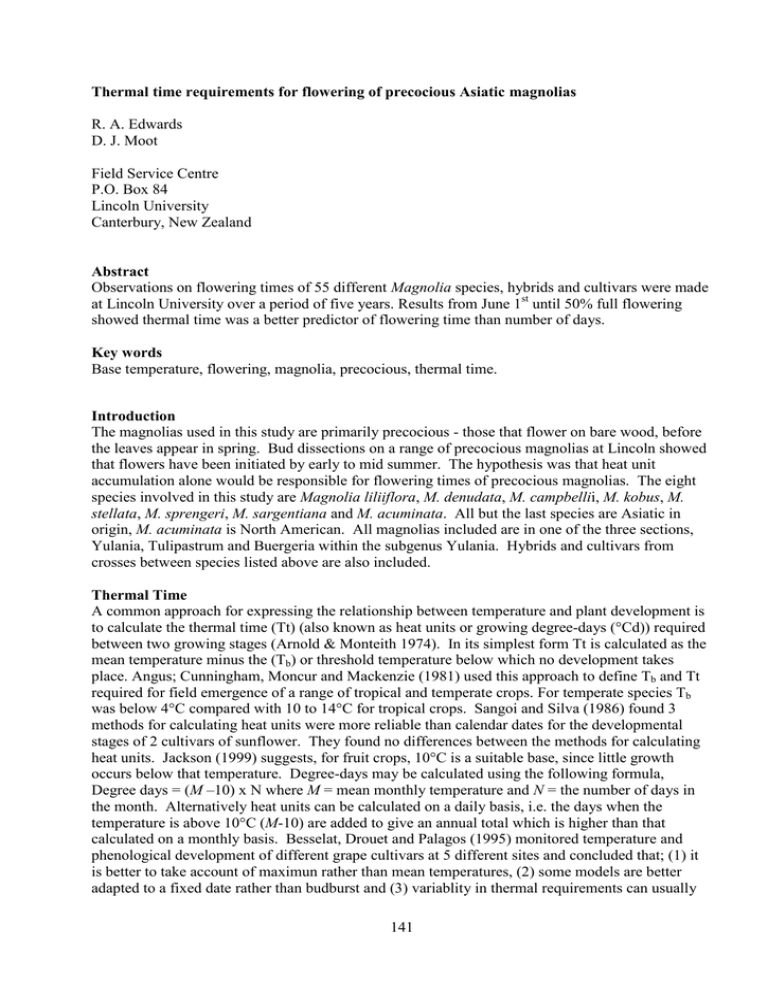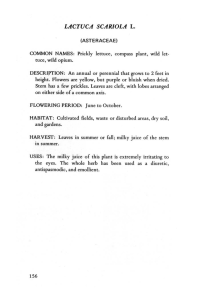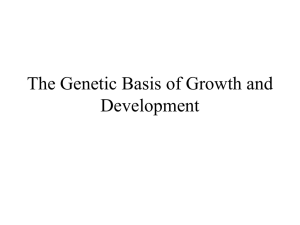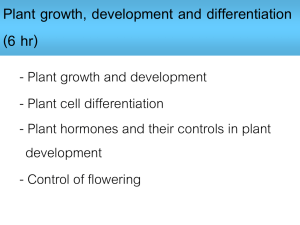R. A. Edwards D. J. Moot Field Service Centre
advertisement

Thermal time requirements for flowering of precocious Asiatic magnolias
R. A. Edwards
D. J. Moot
Field Service Centre
P.O. Box 84
Lincoln University
Canterbury, New Zealand
Abstract
Observations on flowering times of 55 different Magnolia species, hybrids and cultivars were made
at Lincoln University over a period of five years. Results from June 1st until 50% full flowering
showed thermal time was a better predictor of flowering time than number of days.
Key words
Base temperature, flowering, magnolia, precocious, thermal time.
Introduction
The magnolias used in this study are primarily precocious - those that flower on bare wood, before
the leaves appear in spring. Bud dissections on a range of precocious magnolias at Lincoln showed
that flowers have been initiated by early to mid summer. The hypothesis was that heat unit
accumulation alone would be responsible for flowering times of precocious magnolias. The eight
species involved in this study are Magnolia liliiflora, M. denudata, M. campbellii, M. kobus, M.
stellata, M. sprengeri, M. sargentiana and M. acuminata. All but the last species are Asiatic in
origin, M. acuminata is North American. All magnolias included are in one of the three sections,
Yulania, Tulipastrum and Buergeria within the subgenus Yulania. Hybrids and cultivars from
crosses between species listed above are also included.
Thermal Time
A common approach for expressing the relationship between temperature and plant development is
to calculate the thermal time (Tt) (also known as heat units or growing degree-days (°Cd)) required
between two growing stages (Arnold & Monteith 1974). In its simplest form Tt is calculated as the
mean temperature minus the (Tb) or threshold temperature below which no development takes
place. Angus; Cunningham, Moncur and Mackenzie (1981) used this approach to define Tb and Tt
required for field emergence of a range of tropical and temperate crops. For temperate species Tb
was below 4°C compared with 10 to 14°C for tropical crops. Sangoi and Silva (1986) found 3
methods for calculating heat units were more reliable than calendar dates for the developmental
stages of 2 cultivars of sunflower. They found no differences between the methods for calculating
heat units. Jackson (1999) suggests, for fruit crops, 10°C is a suitable base, since little growth
occurs below that temperature. Degree-days may be calculated using the following formula,
Degree days = (M –10) x N where M = mean monthly temperature and N = the number of days in
the month. Alternatively heat units can be calculated on a daily basis, i.e. the days when the
temperature is above 10°C (M-10) are added to give an annual total which is higher than that
calculated on a monthly basis. Besselat, Drouet and Palagos (1995) monitored temperature and
phenological development of different grape cultivars at 5 different sites and concluded that; (1) it
is better to take account of maximun rather than mean temperatures, (2) some models are better
adapted to a fixed date rather than budburst and (3) variablity in thermal requirements can usually
141
be explained as a climatic adaptation, although climatic conditions at the time of flowering can
perturb this effect. Pitacco, Guerriero, Cipriani and Giovannini (1992) describe both chilling units
as the number of hours below 7°C and the number of growing degree hours to determine the
phenological stages of flower and leaf bud development for the peach „Springcrest‟ at 3 different
locations. Salinger, Kenny and Morley-Bunker (1993) investigated the climatic influences on
growing kiwifruit in New Zealand showed the timing of the end of dormancy was determined by
the amount of winter chilling. When sufficient chilling occurred, the time from dormancy end to
bud-burst was positively correlated with temperature over this period but when insufficient chilling
occurred, bud-burst dates were determined by the amount of exposure to low temperature. The
transition from bud-burst to flowering required 415°C days above a base temperature of 7°C to be
completed. Salinger and Kenny (1995) identified three important determinants for the distribution
of kiwifruit cv. Hayward as winter chilling, growing season thermal time and annual rainfall to
enable mapping of the most suitable areas in New Zealand for growing kiwifruit. These were MayJuly temperatures of 11°C as the optimal winter chilling requirement, a thermal time accumulation
of 1100 degree-days above 10°C from October to April and an annual rainfall of 1250mm. SongChiaWei and Ou-ShyKuan. (1997) used a Tb of 10°C to show the time from full bloom of eleven
cultivars of low chill peaches to harvest depended on both the length of the flowering period and the
fruit development period. The eleven cultivars concerned were grouped by thermal time
requirements into early, moderate and late ripening. Erez, Yablowitz, Korcinski, Bodson and
Verhoyen (1998) showed vegetative buds of peaches normally need more heat units to break than
floral buds and they respond differently to higher temperatures. Under natural cool climate
conditions flower buds develop more quickly than vegetative buds adjacent on the same node, while
under warmer conditions, leaf production may advance to the stage that flowering will occur
concomitantly with vigorous vegetative growth.
Methods and materials
During a five-year period between 1998 and 2002 estimates of the percentage of flowering were
made for temperate magnolias in flower in a collection at Lincoln University. Observations were
made for individual species, hybrids and cultivars. The Magnolia collection at Lincoln University
has been developed since 1990 and plants included in this study are typically from the earlier
plantings that now flower regularly. Visual estimates of the percentage flowering were recorded
every 7 days. Estimated flowering percentage data and flowering dates were entered into a database.
Climate data was obtained from Broadfields Meteorological Station nearby and these data were
compared with flowering. June 1st each year was used as a start point for accumulation of thermal
time. Observations made for each species, hybrid or cultivar was based on a sample of the one plant
in the collection. Results were analysed by looking at each plant separately and by aggregating
records for species, hybrids and cultivars with common parents as well as combining the results for
all and comparing heat unit accumulation for each of the five years. Many of the references
reviewed dealt with annual crops, few deal with woody perennials and those that do have
concentrated on thermal time requirements from flowering to fruit harvest. The Tb of 10°C chosen
is the period from spring and is therefore too high for the period being looked at with the magnolias
in this study. Base temperatures between 0°C and 5°C were compared with flowering data 0°C was
selected as appearing to be most appropriate. June 1st was chosen as a starting date each year,
coinciding with the completion of leaf fall for the magnolias involved in this study at Lincoln.
Because the magnolias involved in this study are precocious, leaves were not present until
flowering is well underway for the period and therefore light levels were not considered.
142
Statistical analysis
Calculations of means for 1998 and 1999 as observed against flowering in 2000 as the predicted
were made. Comparisons between groups of hybrids and cultivars of different numbers were
standardised using coefficient of variation (CV). Root mean square deviations (RMSD) were used
to compare days to flowering with accumulation of thermal time (TT).
RMSD formula: {∑ (observed – predicted) 2/n}½ . Observed values come from the mean of years
1998 and 1999 minus 2000 as the predicted.
Results and discussion
Magnolias were analysed individually and collectively based on their reputed parentage (Table 1).
The main parents involved in the 53 magnolias involved are M. liliiflora, M. stellata, M. campbellii
and M. denudata. M. liliiflora tends to have two flowering periods, the main one in early to mid
spring, followed by a lesser flowering in mid or late summer. This characteristic is clearly evident
in a number of cultivars with this parent. M. campbellii tends to be amongst the earliest flowering
and cultivars with this as a parent are variable, but usually early. „Star Wars‟ however will flower
over a large range of times, presumably based on M. liliiflora being the other parent, whilst „Early
Rose‟ has shown it can flower in early August, although at Lincoln is usually early to mid
September (Table 1). The RMSD calculations showed that TT as a predictor of flowering for the
sum of all the magnolias was less than half of that for number of days. (Table 3). All groups except
17 had larger RMSD‟s for number of days compared with those for thermal time. The largest
RMSD‟s for number of days were also generally with the earlier flowering magnolia groups. This
difference was not apparent with the RMSD‟s for TT. It is likely that the earlier flowering
magnolias exhibiting the larger RMSD‟s is due to the variable nature of winter temperatures
compared with the later flowering magnolia RMSD‟s where fluctuations in accumulated
temperature have evened out by this stage. All groups except 5, 8 and 14 had larger CV‟s for
number of days compared with those for thermal time. The largest CV‟s for number of days were
generally with the earlier flowering magnolia groups. This difference was not seen with the CV‟s
for TT.
143
Table 1. Magnolias grouped by similarity of reputed parents
Species, hybrids and cultivars
Groups
a liliiflora
a1 ‘Nigra’
a2 ‘O'Neill’
a3 ‘Reflorescens’
b stellata
b1 ‘Rosea’
b2 ‘Waterlily’
seedling
b3 ‘Waterlily’
c kobus
d denudata
e acuminata
'Klassen'
f campbellii
g sprengeri
f1 ssp. mollicomata g1 sprengeri ‘Diva’
'Lanarth'
h sargentiana var.
f2 ssp. mollicomata
robusta
f3 var. alba
„Ann‟
1
a1
b
„Betty‟, „Susan‟
1
a1
b1
„Pinkie‟
1
a3
b1
„Leonard Messel‟
2
b1
c
„Merrill‟
2
b
c
M. stellata
3
b
„King Rose‟, „Waterlily‟
3
b
„Royal Star‟
3
b2
„Pristine‟
4
b3
M. denudata
5
d
„Forrests Pink‟
5
d
M. kobus
M. liliiflora, M. liliiflora
‘Nigra’
6
c
7
a
M.x brooklynensis „Woodsman‟
8
a2
„Early Rose‟, „Star Wars‟
9
a
f
„Apollo‟, „Vulcan‟
9
a1
f1
M. campbellii
10
f
M. campbellii „Charles Raffill‟
10
ff2
M. campbellii „Strybing White‟
10
ff3
„Heaven Scent‟, „Peppermint Stick‟
11
a
d
f
„Royal Crown‟, „Sayonara‟
11
a
d
f
„Galaxy‟
12
a1
M. sargentiana var. robusta
13
h
M. sprengeri „Burncoose Purple‟
14
g
„Athene‟, „Iolanthe‟
15
a
d
f1
h
„Lotus‟, „Milky Way‟
15
a
d
f1
h
„Manchu Fan‟, „Tina Durio‟, „Todd
Gresham‟
M.x soulangeana
16
a
d
f
17
a
d
„Alba‟, „Alexandrina‟, „Amabilis‟,
„Burgundy‟
„Lennei‟, „Lennei Alba‟, „Norbetii‟,
„Picture‟
„Ruby‟, „Rustica Rubra‟, „San Jose‟
17
a
d
17
a
d
17
a
d
„Sweet Simplicity‟, „Unknown‟,
„Verbanica‟
17
a
d
d
e
g1
144
Table 2. Magnolias first observed at 50% or more of full flowering from June 1st for each of 5
consecutive years at Lincoln University
Species, hybids & cultivars
Observation Date
Group
1998
1999
2000
2001
2002
„Betty‟
1
17/09
13/09
10/09
19/9
13/9
„Ann‟
1
26/09
24/09
21/09
20/9
17/9
„Susan‟
1
19/09
22/09
09/09
20/9
12/9
„Pinkie‟
1
03/09
17/09
19/09
16/9
11/9
„Leonard Messel‟
2
28/08
09/09
06/09
6/9
3/9
„Merrill‟
2
21/09
13/09
14/08
3/9
29/8
M. stellata
3
21/09
24/09
04/09
10/9
4/9
„King Rose‟
3
07/09
13/09
31/08
12/9
9/9
„Royal Star‟
3
04/09
09/09
30/08
6/9
4/9
„Waterlily‟
3
10/09
10/09
21/08
5/9
5/9
„Pristine‟
4
14/09
13/09
31/08
13/9
5/9
M. denudata
5
11/09
10/09
19/08
5/9
31/8
„Forrests Pink‟
5
03/09
03/09
21/08
4/9
29/8
M. kobus
M. liliiflora
6
12/09
27/09
14/09
7/9
5/9
7
21/09
23/09
21/09
26/9
18/9
M. liliiflora „Nigra‟
7
24/09
27/09
18/09
26/9
18/9
M. x brooklynensis‟'Woodsman‟
8
08/10
02/10
06/10
30/9
26/9
„Early Rose‟
9
09/09
28/08
11/08
31/8
29/8
„Star Wars‟
9
07/09
04/09
31/08
12/9
5/9
„Apollo‟
9
17/09
11/09
30/08
8/9
4/9
„Vulcan‟
9
07/09
28/08
24/08
3/9
29/8
M. campbellii
10
14/09
28/08
28/07
27/8
31/8
M. campbellii‟'Charles Raffill‟
10
27/08
03/09
17/08
27/8
29/8
M. campbellii „Strybing White‟
10
18/09
17/09
08/09
12/9
7/9
„Heaven Scent‟
11
13/09
13/09
31/08
14/9
8/9
„Peppermint Stick‟
11
17/09
17/09
07/09
14/9
7/9
„Royal Crown‟
11
12/08
26/08
07/08
1/9
30/8
„Sayonara‟
11
24/09
24/09
16/09
15/9
13/9
„Galaxy‟
12
10/09
06/09
27/08
14/9
5/9
M. sargentiana var. robusta
13
14/09
10/09
07/09
6/9
2/9
M. sprengeri „Burncoose Purple‟
14
04/09
13/09
18/08
30/8
29/8
„Iolanthe‟
15
13/09
10/09
11/09
31/8
30/8
„Athene‟
15
17/09
11/09
07/09
13/9
5/9
„Lotus‟
15
21/09
13/09
07/09
12/9
5/9
„Milky Way‟
15
04/09
09/09
03/09
7/9
5/9
„Manchu Fan‟
16
17/09
10/09
01/09
12/9
5/9
145
„Tina Durio‟
16
05/09
11/09
06/09
15/9
4/9
„Todd Gresham‟
16
21/08
27/08
16/08
5/9
2/9
M.x soulangeana
17
18/09
13/09
07/09
14/9
9/9
„Alba‟
17
11/09
13/09
07/09
11/9
6/9
„Alexandrina‟
17
07/09
10/09
07/09
12/9
6/9
„Amabilis‟
17
17/09
17/09
01/09
8/9
4/9
„Burgundy‟
17
14/09
13/09
31/08
14/9
5/9
„Lennei‟
17
21/09
24/09
21/09
7/9
5/9
„Lennei Alba‟
17
18/09
18/09
14/09
21/9
17/9
„Norbertii‟
17
11/09
13/09
01/09
14/9
10/9
„Picture‟
17
03/09
10/09
24/08
11/9
4/9
„Ruby‟
17
14/09
18/09
07/09
8/9
3/9
„Rustica Rubra‟
17
11/09
17/09
07/09
13/9
5/9
„San Jose‟
17
07/09
03/09
25/08
14/9
7/9
„Sweet Simplicity‟
17
28/09
07/10
21/09
6/9
2/9
„Unknown‟
17
07/09
30/08
24/08
24/9
21/9
„Verbanica‟
17
18/09
17/09
07/09
1/9
30/8
146
Table 3. Mean durations to 50% full flowering for a five year period for temperate (mainly
precocious) Magnolia species, hybrids and cultivars grouped by parentage and recorded from
June 1st each year. Durations are expressed in calendar time (days) and thermal time (TT),
with respective coefficients of variation (CV) and root mean square deviation (RMSD).
Groups
1
2
3
4
5
6
7
8
9
10
11
12
13
14
15
16
17
All
Days from
June 1st.
112
100.2
102.9
104.3
96.2
113
117.7
130.7
97.1
95.9
102.3
99.3
105.7
96.7
105.8
97.7
106.6
CV Days
7.3
15.4
11.2
11.5
13.6
5.8
5.2
6.4
13.8
20.1
16.6
12.1
8.6
15.8
8.2
12.4
10.3
RMSD Days %
Predicted
10.15
26.42
21.87
20.11
28.69
9.91
8.79
3.13
22.71
36.94
17.29
19.32
10.10
33.54
10.97
14.80
14.92
TT
819.6
713.5
731.6
738.6
674.2
807.4
869.4
1021.5
678
675.3
730
698.1
752.4
679.4
757.3
686.5
764.2
17.98
RMSD TT %
CV
TT
8.95
12.98
7.75
2.2
5.65
8.0
4.2
8.6
9.83
16.9
16.7
3.4
5.5
7.9
6.9
12.14
9.97
Predicted
11.41
18.09
7.06
2.94
9.1
1.39
7.69
10.97
7.59
18.3
2.18
2.29
7.4
12.17
8.11
7.28
5.67
8.97
147
Conclusion
TT is a better predictor of flowering than number of days. Early flowering magnolias are likely to
show greater variation in number of days to flowering depending on the vagaries of the winter
weather, more so than the later in spring flowering magnolias, when accumulated thermal time
equates more closely to number of days. This was observed with many of the magnolias with M.
campbellii as a parent during the warmer winter of 2000. In a practical sense the information about
flowering times could be used to plan flowering displays for an event with more certainty later in
the season rather than with early flowering magnolias….
Acknowledgements
The Brian Mason Scientific and Technical Trust for helping fund the development of the Magnolia
collection, without which this study would not have been possible. Bruce Palmer and Cristina Null
for helping to record flowering times. Keith Pollock for helping organise the data on to
spreadsheets.
References
Angus, J.F.; Cunningham, R.B.; Moncur, M.W.; Mackenzie, D.H. 1981: Phasic development in
field crops. I. Thermal response in the seedling phase. Field Crops Research 3: 365-378.
Arnold, S.M.; Monteith, J.L. 1974: Plant development and mean temperature in a Teesdale habitat.
Journal of Ecology 62: 711-720.
Besselat,B.; Drouet,G.; Palagos, B. 1995 Methodology for determining the thermal requirements for
the onset of flowering in grapevines. Journal International des Sciences de la Vigne et du Vin 29:4,
171-182.
Erez, A.; Yablowitz, Z.; Korcinski, R.; Bodson, M. (ed.) Verhoyen, M.N.J. 1998. Temperature and
chemical effects on competeing sinks in peach bud break. Proceedings of the XXV International
Horticultural Congress. Part 4. Culture Techniques with special emphasis on environmental
implications: chemical, physical, biological means of regulating crop growth in vegetables and
fruits, Brussels, Belgium, 2-7th August 1998. Acta-Horticulturae. 2000, 514, 51-58.
Jackson, D.I. Chapter Two: Climate and fruit plants in Jackson, D.I. & Looney, N.E (eds.) 1999
Temperate and subtropical fruit production Second edition, CABI Publishing, Wallingford, UK.
Pitacco, A; Guerriero, R.; Cipriani, G.; Giovannini, D. 1992. Flowering and bud break of peach cv.
„Springcrest‟ grown at three different latitudes. Acta-Horticulturae No. 315: 141.149.
Song-ChiaWei; Ou-ShyKuan. 1997. Thermal time requirement for fruit development in low chill
peaches. Journal of Agricultural Research of China 46:1, 42-50.
Salinger, M.J.; Kenny, G.J.; Morley-Bunker, M.J. 1993. Climate and kiwifruit cv. Hayward. 1.
Influences on development and growth. New Zealand Journal of Crop and Horticultural Science
21:3, 235-245.
Salinger, M.J.; Kenny, G.J. 1995. Climate and kiwifruit cv. Hayward. 2. Regions in New Zealand
suited for production. New Zealand Journal of Crop and Horticultural Science 23:2, 173-184.
148







